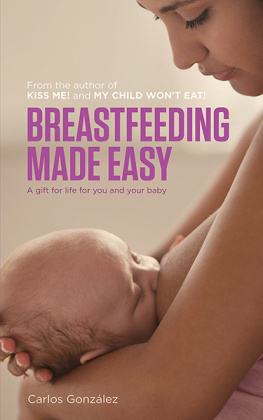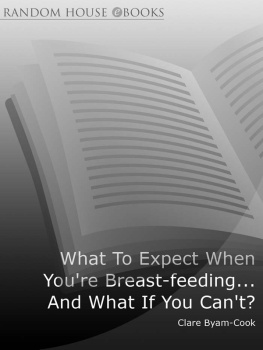Breast Feeding MadeEasy
How To Breastfeed ForMothers Of Newborns
Debra Harper
Copyright 2013 byDebra Harper
SmashwordsEdition
Book published by WellBeing Valley. Well Being Valley is a publishing house which focuseson books relating to physical and mental well-being.
This ebook is licensedfor your personal enjoyment only. This ebook may not be sold orgiven away to other people. If you would like to share this bookwith another person, please purchase an additional copy for eachrecipient. If you're reading this book and didn't purchase it, orit was not purchased for your own use only, then please return toSmashwords.com and purchase your own copy. Thank you for respectingthe hard work of this author.
The informationprovided in this book is designed to provide helpful information onthe subjects discussed. This book is not meant to be used, norshould it be used, to diagnose or treat any medical condition. Fordiagnosis or treatment of any medical problem, consult your ownphysician. The publisher and author are not responsible for anyspecific health or allergy needs that may require medicalsupervision and are not liable for any damages or negativeconsequences from any treatment, action, application orpreparation, to any person reading or following the information inthis book. References are provided for informational purposes onlyand do not constitute endorsement of any websites or other sources.Readers should be aware that the websites listed in this book maychange.
TABLE OFCONTENT
Start BreastFeeding
As you holdyour precious baby for the very first time, you should put his lipsto your breast. Even though mature milk has not been developed yet,the breasts are in the production of colostrum - a substance whichhelps protect your baby from infections. Don't panic if your babyhas difficulty in finding or staying on your nipple. It is verynormal.
The art ofbreast feeding (yes, it is an art) requires tremendous amount ofpatience and practice. You can't expect to be an expert on firstattempt and you must seek for advice or have a medical practitionershow you what to do. Once you start doing it, bear in mind thatnursing wouldn't be painful. Once your baby latches on yourbreasts, pay attention to how your breasts feel.
If it hurts,gently break the suction and try again. Try nursing more frequentlyas the more you nurse, the quicker your mature milk would come inand the more it will produce. Ideally, the target should be 10 to15 minutes per breasts, of around 10 times a day.
When the babycries, it is a signal that he is hungry. However, you should alwayslook to feed the baby before he even starts crying. During thefirst few days of the newborn, it is essential to wake your baby tostart the breast feeding. The baby would even end up falling asleepduring the feeding. To make sure that your baby is eatingregularly, wake him up if it has been more than four hours sincehis last 'meal'.
When the babyfirst starts, it may take more than forty minutes or even longer.Therefore, you should look to be comfortable. If you are sitting ina place where you would be bothered, it makes the process verydifficult. This guide is about that - to teach you how to becomfortable and the factors that you would consider.
WhyYou Should Breast Feed
Research hastried to find what makes breast milk perfect for babies'development. There has been years of research being done on thissubject as we know that during the baby years is when they need toeat a lot of good nutrients.
Researchershave discovered that there are more than two hundred compounds usedin fighting infection, aid digestion and assist the immune system.Regardless of what nature-made ingredients, science simply can't dothe same thing.
There areseveral long term benefits from breast feeding which includesreduced risk of asthma, obesity and some form of child cancer. Asthe researchers do more studies, it has been found that breast milkis extremely good for the development of the child. It not onlymakes the baby healthier, but also makes them smarter. Studies haveshown that babies who are breast-fed tend to be smarter than babiesfed with formulas.
Simplyspeaking, breast feeding helps with the right nutrients and supportbrain growth. Every mother should think deeply about this. Besidesthis, breast feeding doesn't just help the baby but the mother aswell. When a mother breast feed, hormones are released which helpcurb blood loss post-delivery and assist in shrinking the uterus toits normal size.
Over the longterm, mothers would also have a lower risk of premenopausal breastcancer. This cancer is something which strikes women under 50 yearsof age. The benefits of breast feeding can be shown just three tosix months and increase even more when breast feedingcontinues.
Breast feedingis indeed a powerful liquid. It is much better than formula or anyscientific creation that would be created. Making a commitment tobreast feed your child is the best thing you can do, not only foryour child but for you as well.
Besides allthese physical benefits, there are other benefits as well. Thisincludes saving costs of buying the formulas. Formulas are gettingmore and more expensive. When you start breast feeding your child,you would be able to save a tremendous amount of money.
However, nobenefit is more important than allowing the baby to bond with themum. The breast feeding process is a very intimate process. Infact, research has proven that those mothers who breast feed theirchildren tend to be closer than them compared to those people whodon't.
It is clearthat breastfeeding holds various benefits. In the next chapter, Iwould explain the wonderful process in which breast milk ismade.
How IsBreast Milk Made
Any women whohave been pregnant would notice a metamorphosis in their bra cups.There are certain physical changes like tender and swollen breasts,which is the most important indication that you have conceived.
Experts believethat this color change at the areola can be very useful for breastfeeding. This is an indication of the changes that are happeningbiologically. The placenta which is developing would stimulate therelease of progesterone and estrogen. This release help stimulatethe biological system. This assists the lactation process.
Before a womangets pregnant, the larger portion of your breasts is made up of acombination of milk glands, supportive tissue and fat. The truth isyour swollen breasts had been preparing for pregnancy from the timeyou are in your mother's womb. Before a woman is even born, milkducks have already been formed.
However, themammary glands aren't kick started until a women reaches the age ofpuberty. The flood of female hormone estrogen would make them growand swell. During pregnancy, this process moves faster. When thebaby arrives, glandular tissue would have replaced majority of thefat cells and that is the reason why they breasts are bigger.
If a womantakes time to measure their breast, they may even realize that eachbreast is actually 1.5 pounds heavier than previously. Among thebreasts is an intricate network of channels known as milkducts.
Those pregnancyhormones would mean that those ducts would increase in both sizeand number. The ducts would be branched off into smaller canalsaround the chest wall known as ductules. Located at the end of eachduct is a cluster of smaller sacs known as alveoli.
This cluster ofalveoli is known as the lobule. A cluster of lobule is known as alobe. Every breast has around 15 lobes, with a milk duct for everylobe.
The breast milkis produced inside the alveoli, surrounded by tiny muscles withsqueeze the glands and pushes the milk out into the ductules. Thisleads to a bigger duct which widens the milk pool directly belowthe areola.











